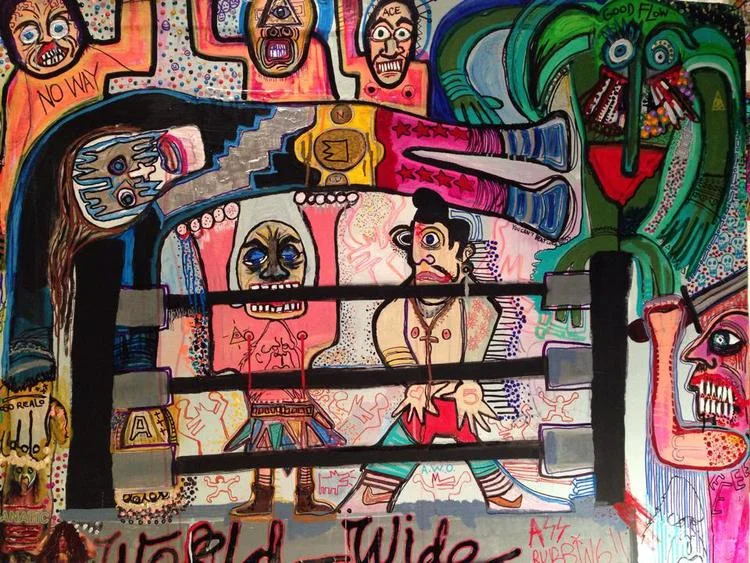Inside Corktown,
America’s Most Dangerous Neighborhood
As revitalization rages through Detroit, one neighborhood is struggling to find its place in the city’s changing landscape.
//aaron foley
© 2015 Sean Nader, "World Wide"
During the recent cold snap that gripped Metro Detroit, Elise Cole came down with a nagging cough that wouldn’t go away. Faced with no other choice, Cole bundled up, lugged her bike ten feet across the living room of her two-bedroom duplex on Bagley Street, and biked two-and-a-half miles to a Rite Aid on Woodward Avenue in Midtown to buy some Robitussin.
“There’s no CVS here in Corktown, no Rite Aid, nothing,” says Cole, who is now feeling better. “This is what we have to put up with living here. And it’s a shame.”
Here in Detroit, this struggling Rust Belt city is gradually pulling itself out of the ruins of bankruptcy, the collapse of the American auto industry, and Super Bowl XL. But change can’t come soon enough for Cole and the other residents of Corktown, a sometimes overlooked community in the shadow of Detroit’s booming downtown.
Though downtown is on the upswing — a new Potbelly just opened, symbolic of the area’s rise — Corktown doesn’t seem to be keeping up with the times. Residents are wondering if they’re being left out from the revival, and if there’s a conspiracy to drive resources to more attractive neighborhoods like West Village.
“I mean, when are we going to get our vegan soul restaurant? Why are certain business owners afraid to come here?” Cole asks.
According to the Pew Research Center, the Knight Foundation, the Kresge Foundation, and a couple of bored college students really into data at Wayne State, the population of Corktown has declined from 1,134 to 1,130 in the last month, prompting concerns from local leaders about what needs to be done to stem the tide.
“All neighborhoods matter,” says Alexis Wiley, the Detroit mayor’s chief of staff. “We certainly want to make sure that all residents are included in the city’s plans going forward, which is why we’ve implemented a special task force to address the specific needs for our neighbors in Corktown.”
When asked how the city is funding that task force, Wiley directed that question to city spokesman John Roach, who then directed that question to public relations firm Truscott Rossman, who then directed that question back to Roach, who then told this reporter to “watch our Twitter feed for updates.”
At the top of list of concerns for Corktown residents is crime. Fearful business owners have put up signs cautioning drivers of car thefts in this blighted neighborhood, filled with decrepit Victorians that look just fine on the outside but are completely gutted on the inside. Stray cats seem to be everywhere, and drug use — specifically marijuana use, maybe a little coke here and there — is not uncommon.
“It’s a nightmare sometimes,” Corey Jones said, looking out at the neighborhood from his second-floor loft in the Grinnell building. “I read the Free Press and the News all the time, and you never read about crime in other neighborhoods. It’s like all of a sudden, all the criminals just started coming here.”
Detroit Police Chief James Craig has attended seven community meetings in Corktown in the last week and has heard residents’ concerns. His department has also diverted resources to the troubled neighborhood, and there is talk of opening a precinct above Slows BBQ, “a place where everyone feels safe.”
TV cameras followed Craig during “Operation Honeybee,” a police raid where more than a dozen offenders were arrested, with crimes ranging from using false addresses for car insurance to urban exploring in the CPA Building. “This type of riff-raff is not welcome in our city,” Craig said into the camera.
But as residents contend with skyrocketing crime, there is another fear lingering, a term residents call “suburban gawkering.”
“They come here from Troy in their fancy Toyota Camrys, spend their money at St. Cece’s, maybe go to the Sugar House for a little bit, and leave,” says Jimmy McDougall, a longtime resident of Corktown who has lived in this neighborhood since 2013. “It’s disrespectful to drive a Toyota here in Detroit. Especially since we’re a Volkswagen neighborhood.”
“But also, it’s this whole idea that they can just come here and take over the places that are staples in our neighborhood,” he added, pointing to the UFO Factory. “They don’t even know what it’s like. We were the ones that made this neighborhood what it is.”
© 2015 Megan LaCroix, "Untitled"
Indeed, some of the neighborhood’s newest restaurants have attracted curious onlookers from as far away as Grosse Pointe Farms. “There’s an energy here that can’t be described,” says Mary Collins, a Pointes woman who grew up on the city’s east side. “The only thing missing is something related to Motown. That would be great, I think.”
As tensions rise between young white Corktown residents and old white Corktown residents; young white Corktown residents and young white suburbanites; young white Corktown residents and young white North Corktown residents; and young white Corktown residents and Mexicans, community conversations have become the norm. Notices for such forums are usually posted online because “everyone in Detroit uses the internet,” one resident writes on Facebook.
The aforementioned Detroit Free Press has opened a bureau in Corktown next to Batch Brewing Co. It is led by Stephen Henderson, the city’s sole black writer who somehow found time for this endeavor in between hosting six public radio shows, five public television shows, co-hosting a show on one of the local affiliates, teaching a night class at Central Michigan University, and writing an advice column for Metro Detroit Bride.
“I know I have a platform with white Detroiters because I’m pretty much everywhere. And we’ve especially got plenty of white folks here at the Free Press,” Henderson said in an emailed statement. “I plan on using that platform to bring more attention to this marginalized community.”
Still, there are those like Cole who patiently wait for the revival to come.
“I don’t always like it, but let’s get one thing straight. I choose to be here in Corktown. I could go anywhere else, like Clawson, but this is my home. I have a right to be here, despite what the challenges are,” she says over a charcuterie plate.
//Aaron Foley is a Detroit-based writer and near-lifelong resident. His work has appeared in several local and national publications.



